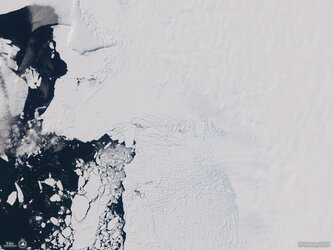Antarctic Peninsula glaciers on the run
Like many places, the Antarctic Peninsula is falling victim to rising temperatures. However, when scientists used radar images from the Copernicus Sentinel-1 mission acquired between 2014 and 2021, they were taken aback to discover just how the fast 105 glaciers on the west coast are flowing in the summer months.
The Antarctic Peninsula is the most northern and warmest region of Antarctica, and with a 1000-km long mountainous spine, it is home to a rich marine ecosystem. The peninsula holds enough ice to raise global sea levels by around 7 cm and is rapidly changing in response to the climate crisis.
Along the west coast of the peninsula, over 100 large glaciers drain ice from the ice sheet directly into the Southern Ocean.

A team of scientists from the University of Leeds in the UK and the Utrecht University in the Netherlands processed over 10,000 Copernicus Sentinel-1 radar images to measure the speed of 105 glaciers on the Peninsula’s west coast over a six-year period, from 2014 to 2021.
The paper published today in Nature Geoscience describes how they found that the glaciers experiencing the most seasonal change actually flow over 22% faster in summer than winter, with all glaciers in this region speeding up by 12% on average. This new discovery of faster summer ice speeds has not been seen before in this region of Antarctica.
Climate models of snow melt and ocean temperature were used to investigate what was driving this summer speedup.
The data showed that the glacier speed-up occurs at the same time as water from melting snow and warmer ocean temperatures are present in the summer, showing how glaciers in this region of Antarctica can respond quickly to changes in the environment.

Ben Wallis, from the University of Leeds, said, “What’s exciting about this study is that it shows how sensitive glaciers in Antarctica are to the environment. We’ve known for a long time that glaciers in Greenland have a seasonal behaviour, but it’s only now that satellite data has shown similar behaviour in Antarctica.
“Originally, we didn’t plan to focus on the west coast of the Peninsula, but after seeing some interesting signals on Breguet Glacier, we investigated further and found summertime speed-ups were widespread along the whole coast.”
Anna Hogg, also from the University of Leeds, added, “These results show that it is essential to account for short-term seasonal change in glacier speeds when measuring how much ice is being lost from Antarctica and contributing to global sea-level rise.
“The Antarctic Peninsula has seen some of the most rapid warming of any region on Earth. Continuing work like this will help glaciologists monitor how quickly change is occurring, enabling accurate assessments of how Earth’s ice will respond to climate change.”


Access the video
Thanks to its ability to acquire images regardless of day or night and in all-weather conditions, the Copernicus Sentinel-1 radar mission is key to monitoring ice change in the polar regions. While there are still two more Sentinel-1 satellites to launch in this family to continue the work of the first two satellites, other satellites in a new family of Copernicus Sentinel Expansion Missions are being built that will take polar monitoring further into the future.
ESA’s Craig Donlon noted, “This study highlights how high-resolution satellite images can help us monitor how the environment is changing in remote regions. Future satellites, such as the family of Copernicus Sentinel Expansion Missions, promise to bring enhanced continuity and capabilities that will spearhead further insight into the characteristics and processes governing ice mass balance and sea-level rise.”














 Germany
Germany
 Austria
Austria
 Belgium
Belgium
 Denmark
Denmark
 Spain
Spain
 Estonia
Estonia
 Finland
Finland
 France
France
 Greece
Greece
 Hungary
Hungary
 Ireland
Ireland
 Italy
Italy
 Luxembourg
Luxembourg
 Norway
Norway
 The Netherlands
The Netherlands
 Poland
Poland
 Portugal
Portugal
 Czechia
Czechia
 Romania
Romania
 United Kingdom
United Kingdom
 Slovenia
Slovenia
 Sweden
Sweden
 Switzerland
Switzerland































